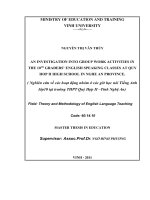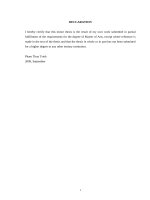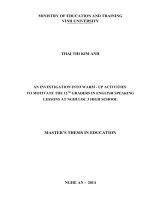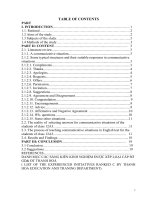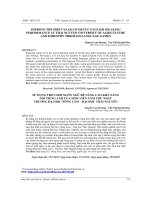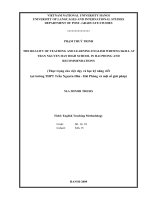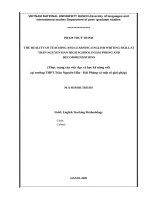An investigation into factors affecting students english speaking performance at tran cao van high school in tam ky quang nam province
Bạn đang xem bản rút gọn của tài liệu. Xem và tải ngay bản đầy đủ của tài liệu tại đây (1.18 MB, 95 trang )
STATEMENT OF AUTHORSHIP
I hereby acknowledge that this study is mine. The data and findings discussed
in the thesis are true, used with permission from associates and have not been
published elsewhere.
Author
Le Kieu Lan Phuong
i
ACKNOWLEDGEMENTS
This thesis would not have been completed without the help
of many people.
First and foremost, I would like to express my sincere
gratitude to my supervisor, Dr. Ngu Thien Hung, for his
professional guidance and excellent support at the very
beginning of the research.
Second, I would like to save my deep gratefulness to Dr. Le
Pham Hoai Huong for her suggestion about my thesis’s title.
Third, my warm thanks also go to my cousin, Ms. Huynh Ngoc
Mai Kha for all her kind help she gave me during the time I
conducted my study.
I would like to send my special thanks to English teachers and
grade 10 students at Tran Cao Van High School who took part
in my research as samples.
ii
In addition, I would like to express my deep thanks to Ms. Tran
Thi Thu Suong for making helpful comments on my thesis.
Finally, I want to show my profound gratitude to my parents,
my younger brother, my husband and my daughter for their
understanding, support and love during the implementation of
this project.
iii
ABSTRACT
Developing students’ English speaking performance is one of the challenges facing
teachers of English. It is not only concerned with the nature of language teaching
and learning from linguistic perspectives, but also influenced by other factors. So,
this study has been conducted with the aims to find out factors affecting students’
English speaking performance to help English teachers understand the difficulties of
students in their English speaking performance and to draw better solutions to
improve English speaking performance of students at Tran Cao Van High School.
Three instruments (1) questionnaires for students and teachers, (2) students and
teachers interviews and (3) class observations were used to collect both quantitative
and qualitative data. The participants of the study are 100 grade ten students and
twelve teachers teaching English at Tran Cao Van High School in Tam Ky CityQuang Nam Province in the school year of 2010-2011.
Basing on the analysis of the statistical data from the interviews and questionnaires,
this paper focuses on the discussion of the impacts of the factors, especially the
factors relating to students themselves on their speaking in English at high schools.
The findings reveal that students at Tran Cao Van High School have many problems
in their speaking class, including having difficulty in speaking and expressing their
ideas in English, taking little participation in the speaking activities, being teacher
and peer pressure and having no chance to practice speaking English. Also, there
are also many factors leading to problems students at Tran Cao Van High School
have in their English speaking class and affecting their English speaking
performance. They consist of external factors and factors relating to students
themselves. Additionally, many suggestions made by both teachers and students for
the sake of helping students overcome the factors affecting students’ English
speaking performance, especially the ones relating to themselves to improve their
English speaking performance better and better have also been given.
iv
TABLE OF CONTENTS
STATEMENT OF AUTHORSHIP ..................................................................... i
ACKNOWLEDGEMENTS ...............................................................................ii
ABSTRACT ...................................................................................................... iv
TABLE OF CONTENTS ................................................................................... 1
LIST OF FIGURES ............................................................................................ 4
LIST OF TABLES ............................................................................................. 5
LIST OF ABBREVIATIONS ............................................................................ 6
CHAPTER 1. INTRODUCTION....................................................................... 7
1.1 Rationale of the research .......................................................................... 7
1.2 Aims and objectives of the research ........................................................ 9
1.2.1 Aims of the research ......................................................................... 9
1.2.2 Objectives of the research ............................................................... 10
1.2.3 Research questions.......................................................................... 10
1.3 Scope of the research ............................................................................. 10
1.4 Significance of the research ................................................................... 11
1.5 Organization of the research .................................................................. 11
CHAPTER 2. LITERATURE REVIEW.......................................................... 13
2.1 English speaking performance ............................................................... 13
2.1.1 Definition of speaking skill ............................................................ 13
2.1.2 Definition of speaking performance ............................................... 14
2.1.3 Linguistic aspects contributing to the evaluation of English
speaking performance.................................................................... 15
2.2 Factors affecting students’ English speaking performance ................... 17
2.2.1 Internal factors of language users ................................................... 18
2.2.2 External factors ............................................................................... 24
2.3 Previous studies related to English speaking performance .................... 29
2.3.1 Studies proposing activities used to improve students’ English
speaking performance.................................................................... 29
1
2.3.2 Studies proposing how to organize teaching activities to improve
students’ English speaking performance ....................................... 32
2.3.3 Other related studies ....................................................................... 33
2.4 Summary ................................................................................................ 35
CHAPTER 3. RESEARCH METHODOLOGY .............................................. 36
3.1 Research design ...................................................................................... 36
3.2 Hypotheses ............................................................................................. 37
3.3 Participants ............................................................................................. 37
3.4 Data collection methods ......................................................................... 38
3.4.1 Questionnaires ................................................................................ 38
3.4.2 Interviews........................................................................................ 40
3.4.3 Class observations .......................................................................... 41
3.5 Data analysis .......................................................................................... 42
3.6 Summary ................................................................................................ 42
CHAPTER 4. FINDINGS AND DISCUSSIONS............................................ 43
4.1 Problems encountered by students in their speaking classrooms .......... 43
4.1.1 Students’ opinions about speaking in English ................................ 43
4.1.2 Problems students have in their speaking classrooms .................... 45
4.2 Factors leading to problems encountered by students at Tran Cao Van
High School in their English speaking class and affecting their English
speaking performance ............................................................................ 48
4.2.1 Reality of students’ English speaking performance ....................... 49
4.2.2 Factors leading to problems students have in their English speaking
class and affecting their English speaking performance ............... 49
4.2.2.1 External factors ........................................................................ 52
4.2.2.2 Factors relating to students themselves ................................... 53
4.3 Suggestions for the improvement of students’ English speaking
performance ........................................................................................... 65
4.3.1 Students’ suggestions...................................................................... 65
4.3.2 Teachers’ suggestions ..................................................................... 67
4.4 Summary ................................................................................................ 68
2
CHAPTER 5. CONCLUSION AND IMPLICATIONS .................................. 69
5.1 Summary of Findings ............................................................................. 69
5.2 Implications ............................................................................................ 72
5.2.1 For teachers ..................................................................................... 72
5.2.1.1 Class management ................................................................... 72
5.2.1.2 Adapting tasks ......................................................................... 73
5.2.1.3 Assessment .............................................................................. 74
5.2.2 For school administrators ............................................................... 74
5.3 Limitations of the study ......................................................................... 75
5.4 Suggestions for further research ............................................................ 75
5.5 Conclusion.............................................................................................. 76
REFERENCES ................................................................................................. 77
APPENDIX 1: QUESTIONNAIRE FOR STUDENTS
APPENDIX 2: QUESTIONNAIRE FOR TEACHERS
APPENDIX 3: QUESTIONS FOR STUDENT INTERVIEW
APPENDIX 4: QUESTIONS FOR TEACHER INTERVIEW
3
LIST OF FIGURES
Figure 4.1: Students’ feelings of learning speaking in English (Data collected from
interviews and questionnaire for students). ............................................................... 43
Figure 4.2: Students’ expressions of the interests in speaking in English (Data
collected from interviews and questionnaire for students) . ..................................... 44
Figure 4.3: Student’s opinions about the importance of speaking in English (Data
collected from interviews and questionnaire for students). ...................................... 44
Figure 4.4: Reality of students’ English speaking performance (Data collected from
interviews and questionnaire for students). ............................................................... 49
Figure 4.5: Students’ opinions about the role of ELP on students’ ESP. ................ 53
Figure 4.6: Teachers’ opinions about the role of ELP on students’ ESP. ................ 54
Figure 4.7: Grades for Students’ English Speaking Performance. .......................... 57
Figure 4.8: Students’ difficulties in ESP with low ELP (Data collected from
questionnaire for students). ....................................................................................... 58
Figure 4.9: Students’ difficulties in ESP with low ELP (Data collected from
questionnaire for teachers). ....................................................................................... 58
Figure 4.10: Students’ perspectives of influence of shyness to their ESP. .............. 60
Figure 4.11: Students’ perspectives of influence of topical knowledge on their ESP. .... 63
Figure 4.12: Percentage of students agreeing the effect of topical knowledge on
ESP. ........................................................................................................................... 64
4
LIST OF TABLES
Table 4.1: Problems students have in the speaking class (Data collected from
interviews and questionnaire for students). ............................................................... 46
Table 4.2: Problems students have in the speaking class (Data collected from
interviews and questionnaire for teachers). ............................................................... 47
Table 4.3: Factors affecting students’ English speaking performance (Data
collected from questionnaire for students). ............................................................... 50
Table 4.4: Factors affecting students’ English speaking performance (Data
collected from questionnaire for teachers). ............................................................... 51
Table 4.5: Students’ perspectives of necessary aspects of ELP for ESP. ................ 55
Table 4.6: Teachers’ perspectives of necessary aspects of ELP for ESP. ................ 56
5
LIST OF ABBREVIATIONS
BBC:
British Broadcasting Corporation
EFL:
English as a Foreign Language
ELP:
English language proficiency
ESP:
English speaking performance
L2:
Second language
6
CHAPTER 1
INTRODUCTION
In this chapter, I will describe in details the rationale of the research in relation
to the ability of speaking English of students at Tran Cao Van High School in Tam
Ky City- Quang Nam Province, the aims and objectives of the research, the scope of
the research, the significance of the research and the organization of the research.
1.1 Rationale of the research
With the tendency of integration and globalization, especially with the recent
popularity of English as an international language of communication, the role of
English can not be denied nowadays. English has become more and more popular
and significantly important “for foreign travel, business or other professional
reasons” (Donough, 1999, p.151). So, proficiency in English communication is
becoming more than just an educational requirement.
Besides the new curriculum designed and changed by the Vietnamese Ministry
of Education and Training for the sake of helping learners approach the new
tendency of the world, the renovation in methodology of teaching and learning
English has been the prime focus of many debates in workshops in Vietnam. There
has been a shift of emphasis from passive learning to active learning. As a result,
many new textbooks and syllabus are designed according to communicationoriented and learner-centered approaches, which all require teachers of English to
improve their teaching skills to make students more competent to deal with the real
communication. Accordingly, learners should not only be good at grammatical
knowledge, but also be able to communicate successfully.
In reality, it is very difficult for teachers to improve students’ language
competence, especially English speaking competence. Speaking has long been
considered a difficult and boring subject by many language learners. In fact, among
the four basic skills- listening, speaking, reading and writing- that all learners have to
develop when they learn a foreign language, speaking is the hardest for teaching and
7
learning. “To most people, mastering the art of speaking is the single most important
aspect of learning a foreign language and the success is measured in terms of the
ability to carry out a conversation in a language” (Nunan, 2000, p.39). Speaking is, in
fact, a real challenge to both language teachers and language learners. As stated by
Thornbury (2005, p. iv), “speaking is interactive and requires the ability to co-operate
in the management of speaking turns. It also typically takes place in real time, with
little time for detailed planning”. It is also reaffirmed by Nunan (2003, p.48) that
“unlike reading or writing, speaking happens in real time: usually the person you are
talking to is waiting for you to speak right then”. So, it is very difficult for you to
“edit and revise what you wish to say, as you can if you are writing”.
Being English teachers, we are responsible for helping students understand the
importance of learning English and use English in communication as well. It is also
necessary for us to understand what students want to learn, how they learn and what
difficulties affect their process of learning so that we can determine our philosophy
of education, teaching style, approach, methods, class techniques and activities to
help them overcome the obstacles in learning English as well as improve their
communication competence in English more and more effectively.
The question regarding how to improve students’ English speaking
performance (ESP) is indeed a matter of concern for both EFL teachers and
learners. It is indeed bitter to notice that even though serious efforts have been made
to improve students’ English speaking performance, students do not perform well in
English communication as they are supposed to do. There may be many factors
affecting students’ English speaking performance.
From the way English is taught in Vietnam and in my school, Tran Cao Van
High School, we can see that the teaching of speaking skill is not paid attention to as
much as other skills such as reading and writing. The English teaching tends to focus
mainly on grammar, reading and writing skills while speaking and listening skills
generally receive little attention, which detracts the basic goal of learning a foreign
language. Most students do not pay attention to English speaking skill; conversely,
they only want to learn what involved in their final examination and the National
8
Entrance Examination to be admitted to university. As a result, their English speaking
performance is not good.
Moreover, speaking is a basic language skill that is not easy to master when
there are no conditions, environments and time for students to practice it. It is the
regular practice that helps students be more self-confident to communicate with
people who use that language in unrehearsed situations. In reality, there are few
opportunities for students in my school to use and perform their speaking in English
outside the classroom, which is also an important factor more and less affecting
students’ improvement in their ESP. Besides, English language proficiency (ELP) is
also a big challenge facing students in learning English speaking skill.
It is clear that developing student’s communication competence is not only
concerned with the nature of language learning from linguistic perspectives, but
could also be influenced by many exogenous factors. In this stance, it is my
decision to conduct “An investigation into factors affecting students’ English
speaking performance at Tran Cao Van High School in Tam Ky City- Quang
Nam Province”. I strongly believe that identifying the factors that lead to problems
students have in their speaking class and that affect students’ English speaking
performance is very important to our English teaching. Understanding these factors
and their impacts would enable us to know better the reasons why our students have
little confidence in speaking English so that we have good solutions to help students
better their English speaking performance.
1.2 Aims and objectives of the research
1.2.1 Aims of the research
It is hoped that the findings of this study will help teachers identify the factors
hindering students from speaking in English well in class. From that, teachers can
find out affective ways to help their students improve their English speaking
performance. Thus, the study has two-folded aims as follows:
9
To find out factors affecting students’ ESP to help English teachers
understand the difficulties of students in their English speaking
performance.
To draw better solutions to improve English speaking performance of
students at Tran Cao Van High School.
1.2.2 Objectives of the research
To achieve the aims of study I attempt to pursue the following objectives:
To find out problems students have in their English speaking class.
To investigate into factors, especially ones relating to students themselves,
causing problems students at Tran Cao Van High School face in English
speaking class and affecting their English speaking performance.
To suggest solutions to the problems under investigation.
1.2.3 Research questions
The study is intended to seek the information for the following questions:
1. What problems do students have in their speaking classrooms?
2. What factors lead to problems students at Tran Cao Van High School
have in their English speaking class and affect their English speaking
performance?
3. What should be suggested to improve students’ English speaking
performance?
1.3 Scope of the research
While much previous research has been conducted to find out factors affecting
students’ English speaking skill, to make changes, or to suggest some activities to
promote students’ speaking ability, this project is unique that investigate factors,
especially factors relating to students themselves causing students many problems
in their learning of English speaking and affecting the ESP of students who are
10
studying at Tran Cao Van High School with the aim to make some suggestions to
help them be confident in their English speaking performance.
Furthermore, with the aim to lay good foundation for students to be confident
in performing their speaking in English not only in grade 10 but also in the next
years at high schools as well as Universities, grade 10 students studying their first
year at the Upper Secondary School are chosen for this study. It is expected that
finding out the factors affecting students’ performance in speaking English and
helping them overcome those obstacles will play an important role in teaching and
learning English speaking.
1.4 Significance of the research
It is expected that this study will be useful for English teachers in
understanding the obstacles to students’ speaking English performance. From the
results of the research, English teachers will have a good understanding of factors
causing problems that hinder students from learning speaking skill and making them
hesitate at performing their English speaking ability. Then the paper would propose
solutions to help students at Tran Cao Van High School improve their English
speaking performance.
1.5 Organization of the research
The research report is presented in five chapters: (1) Introduction, (2)
Literature review, (3) Research methodology, (4) Findings and Discussion (5)
Conclusion and Implications.
Chapter one presents a statement of problems concerned to the learners’ ESP
at Tran Cao Van High School. The background information on the problems and the
reasons to conduct the research is mentioned in this part to assert that the problems
being addressed are researchable. Then it introduces the aims and objectives of the
study. The scope of the study is also mentioned with the aim to clarify the limitation
as well as the goal of the study. Finally, the significance of the research and the
structure of the research are stated at the last part of the chapter.
11
The first part of Chapter two is to define the terms related to speaking skill
and ESP. Besides, linguistic aspects contributing to the evaluation of English
speaking performance are also passed in details in this chapter as a reference source
for the researcher to base on and consider which one should be taken into
consideration to help students in high schools improve their English speaking skill.
The second one focuses on examining available studies and opinions from other
researchers that are related to the factors affecting students’ ESP as a basis for the
literature review.
The research design and the procedures, the participants are described in the
research methodology in Chapter three. And it presents in details instruments for
data collection and explains how the data are analyzed.
The results of the research taken from questionnaires, interviews and class
observations on the English speaking performance of students at Tran Cao Van
High School are revealed in Chapter 4. They are also compared together to find out
the basic factors that make students less confident in their English speaking
performance.
The last chapter, Chapter 5, is used to summarize and interpret the main
results of the research in terms of original hypothesis. It also discusses the
theoretical and practical implications of these findings based on the results of the
research to improve students’ ESP at Tran Cao Van High School. Finally, the
limitations and the suggestions for further research are mentioned here.
Besides, appendices of questionnaires, interviews, reports of class
observation and references are also included at the end of the thesis.
12
CHAPTER 2
LITERATURE REVIEW
The first of this chapter is especially for the reviews of the background theory
related to speaking skill, speaking performance and linguistic aspects contributing
to the evaluation of English speaking performance. For the second part, the previous
studies related to factors affecting students’ English speaking performance are
presented in this chapter as the main part of this study. It also includes studies
proposing activities used to improve students’ English speaking performance,
studies proposing how to organize teaching activities to improve students’ English
speaking performance and other related studies.
2.1 English speaking performance
2.1.1 Definition of speaking skill
Speaking is people’s need. It is a part of getting along with people. People
speak with the purpose to make others know what they need as well as help them
know others. For this reason, Thornbury (2005, p.1) has defined speaking as “a part
of daily life that we take it for granted”.
There are many definitions of speaking. As stated by Nguyen (2008), speaking,
a process of oral language production, is more complicated in the process of
development than it seems and involves more things than just pronouncing words.
In The Oxford Pocket Dictionary of Current English, speaking is defined as an
action of conveying information or expressing one's thoughts and feelings in spoken
language. It is the interchange of thoughts, information or feelings between people
living in the society. In life, speaking is used to establish the self-esteem, build
relationships and assess feelings and information.
According to Theodore (1983) cited by Susanti (2007), “language is
essentially speech, and speech is basically communication by sounds”. He adds that
“speaking is a skill used by someone in daily life communication whether at school
13
or outside. The skill is acquired by much repetition. It consists of competence in
sending and receiving messages.” Another definition of speaking stated by Chaney
is that “speaking is the process of building and sharing meaning through the use of
verbal and non-verbal symbols in a variety of contexts.” (1988, p.13)
From the above definitions, it can be inferred that speaking is one of abilities
to carry out conversation on the language. It is an interactive process of constructing
meaning, receiving and processing information. Mastering speaking skill can help
people carry out conversation with others, give ideas and change the information
with interlocutor. Furthermore, besides ability, according to Koizumi (2005),
speaking is also a performance. He says that speaking can be seen from two
perspectives: ability and performance. So, what is speaking performance?
2.1.2 Definition of speaking performance
Speaking performance is defined as actual instances of producing oral language
in real time. It is regarded as including aspects of fluency, accuracy, syntactic
complexity and lexical complexity (McNamara, 1996, p.54 cited in Koizumi (2005,
p.36) Different from what was assumed in the past that speaking performance was
easily conducted and only “followed naturally form the teaching of grammar and
vocabulary, with a bit of pronunciation thrown in”, speaking performance is now much
more complex and involves both a command of certain skills and several different
types of knowledge. Speaking performance can nowadays be inferred as the way of
performing a speech, for example, the accuracy and the fluency in speaking, the
vocabulary are used, the appropriateness of the speech or whether the speech is
intelligible to the listeners.
From the definition of speaking performance, it is clear to see that speaking
performance is in the relationship with linguistic aspects. It reflects learners’
language proficiency, which is one of the factors having the great impact on
students’ English speaking performance. So, the analysis of linguistic aspects to
speaking performance will be analyzed in the next part of this chapter.
14
2.1.3 Linguistic aspects contributing to the evaluation of English
speaking performance
According to Koizumi, “speaking performance can be seen from such
linguistic aspects as fluency, accuracy, lexical resources, syntactic complexity,
quality and quantity of contents, cohesion and coherence, sociolinguistic
appropriateness, use of communication strategies, pronunciation and other aspects”
(2005, p.43). However, with recent extensive use together with the real situations of
teaching and learning English speaking skill in high schools, the concern in this
study is focusing on four of the aspects of linguistics that contribute to the
evaluation of English speaking performance including fluency, accuracy, lexical
resource and quality and quantity of contents for the sake of helping students more
and more competent in their English speaking performance.
As regarded by Brumfit (1984), cited in Koizumi (2005) and Shumin (cited in
Richards and Renandya (2002)), fluency and accuracy are essential aspects of
speaking performance and have complementary roles. Nawshin (2009) also
emphasizes that in order to be good at speaking performance, speakers “should pay
attention to both fluency and accuracy” because, in his opinion, speakers might get
nervous when speaking in front of a large audience if they lack accuracy and fluency
in speaking. That is also the reason why many linguists (Nunan, 2003; Brown, 2004;
and Nawshin, 2009) mention accuracy and fluency as the first criteria for principles
of teaching speaking skill.
Fluency
The ability of speaking English fluently opens up wider opportunities to
achieve success in life. For that reason, it is said in BBC- Better Speaker (2003) that
“Speaking English fluently is a goal for many learners of English. Fluency means
being able to communicate the ideas without having to stop and think so much
about what you are saying”. It is defined as how fast and how much a learner can
speak. It also refers to how good students are at keeping talking at the right speed
and how good they are at connecting their ideas together. It expresses the capability
15
of the speakers to “use the target language quickly and confidently with few
hesitation or unnatural pauses, false starts, words searches” (Nunan, 2003, p.55).
Accuracy
“Speaking accurately means that you speak without errors of grammar and
vocabulary” (BBC- Better Speaker, 2003). As stated by Nawshin (2009, p.10),
“accuracy means the correct use of language in terms of vocabulary, grammar and
pronunciation”. Accuracy plays a very important role in speaking because it is
“the extent to which students’ speech matches what people actually say when they
use the target language” (Nunan, 2003, p.55). In the process of speaking and
listening, there may be two kinds of comprehension problems that result from
inaccuracy. First, the listener who does not understand what the speaker is trying
to say will cause the communication breakdown. The second problem of
communication is due to errors leading to misunderstanding or ambiguity. With
those above problems, the listeners can come to a decision not to make extra effort
required interpreting non- standard forms. So, accuracy is seen as an essential part
to refine the communicative performance.
However, focusing so much on accuracy of speaking sometimes destroys
students’ fluency of speaking. As regards this problem, Pattison (1987, p.17)
contends that “the aim is not to produce learners who can speak exactly like native
speakers of the FL (in terms of accuracy), but learners who can communicate with
native speakers (in terms of fluency)” He adds that people’s success in speaking is
“decided by their ability to understand and to make themselves be understood”.
Lexical resource
Regarding to lexical resource, this refers to how much vocabulary students can
use and how well they use it. Levelt (1993) cited in Koizumi (2005) notes that
vocabulary is one of the essential and fundamental components of communication.
In fact, vocabulary has a central position in forming an utterance with appropriate
meanings and with syntactic, morphological, and phonological structures. No
speech can be produced without vocabulary and vocabulary is indispensable to
16
speaking performance. So, students’ success in performing English speaking skill
much depends on their lexical resource.
Quality and quantity content
Another aspect of speaking performance is relating to the quality and quantity
content. It first indicates the meaningful relationship between speakers and listeners.
It also expresses students’ ability to use “spoken language effectively as required by
the formal school environment, express the main ideas in text to others describe as
well as explain clearly ideas to others and engage the listeners”1. It also requires
students to consider the ways in which spoken text is used to communicate
meaningfully through the quality of ideas, to justify opinions and to engage the
audience. To do so, it requires students to be able to complete a set of speaking
tasks under controlled conditions such as telling a story, offering an opinion to
convince a listener.
In short, it is required of students that they must be competent at aspects of
linguistics contributing the good speaking performance to be good at speaking in
English. They have to be able to pronounce clearly, organize and develop ideas in
real time, produce phrases, ask for clarification and check understanding as well.
Also, it requires students good knowledge about English language such as
knowledge of grammar systems, knowledge of appropriate language to use,
knowledge of suitable exchange patterns to use, knowledge of phonology,
knowledge of topic, awareness of what your speaking partner knows and interests.
2.2 Factors affecting students’ English speaking performance
Most of the students complain that they understand English, but do not
perform it well. They worry that “they are going to make a mistake” or that “the
people listening will not understand them” (BBC- Better speaker, 2003). They are
afraid of being laughed at when they make mistakes, etc. From the above ideas, we
can clearly see that speaking performance of a foreign language is really a challenge
1
/>
17
to students. In order to provide effective guidance on improving students’ ability in
speaking English as well as developing students to become component speakers, it
is necessary to examine the factors that make students hesitate to perform their
speaking in English.
With regard to second language acquisition, there are many ideas related to
this issue. According to Lightbown and Spada (2000, p.49), every learner has
certain characteristics which more or less lead to their success in learning a
language. This idea is also expressed by Brown (1994, p.134) that there exist two
facets of the affective domain that needs to be analyzed to have a greater
understanding of the language learning process as well as to improve language
teaching methods. The first of these is the “intrinsic side of affectivity” related to
“personality factors within a person” and the second is “extrinsic factors” including
“socio-cultural variables”. In both facets of affective domain, there are many factors
that “contribute in some way to the success of language learning”. Conversely,
some factors are big barriers that deter students from learning a foreign language.
With an increasing awareness of the necessity in researching and teaching a second
language, assisting students in their performance of speaking in English as well as
helping them more and more successful in communicating, many studies on factors
that negatively affect students’ ESP are conducted with the aim to find out solutions
to perplexing problems. There are two major factors that affect students’ speaking
performance: internal factors of language users and external factors.
2.2.1 Internal factors of language users
Poor attitudes and low motivation
The role of attitudes and motivation is of importance to learning a second
language. Various studies have found that motivation is very strongly related to
achievement in learning a language. With the positive attitudes and motivation,
students will be successful in learning many subjects in general and learning English
in particular. This point is supported by Brown (1994, p.152) and Remer Sasson
(cited in Nguyen, 2008) when they say that “motivation is a key to learning “and “the
inner power or energy that pushes one toward performing a certain action”.
18
In regard to the purpose of learning, motivation, in Sterm’s view, is stated as
the characteristic of learners. It “ initiates and maintains the learning process, or
leads to the avoidance or rejection of learning; the stated reasons and perceived
goals as well as the subconscious drives and needs that prompt and sustain the
learning effort or lead to its inhibition or rejection”(cited in Nguyen, 2008). And
talking about attitudes towards learning a foreign language, Sterm (1983, p.376)
cited in Ellis (1985, p.118) “classifies these attitudes into three types: attitudes
towards community and people who speak the second language; attitudes towards
learning the language concerned; and attitudes towards languages and language
learning in general”. Similarly, according to Lightbown & Spada (2000, p.56),
motivation in second language learning is built based on two factors: “learners’
communicative needs and their attitudes towards the second language community”.
When the communicative value of the second language can be perceived by
students, they will be motivated to acquire proficiency in it. Simultaneously, people
only want to use the second language when they have good attitudes towards the
speakers of that language. Learning a second language will be a source of
enrichment when it is learnt purposely. In contrast, as stated by Lightbown &
Spada, (2000, p.56), it can be “a source of resentment when the students’ only
reason for learning is external pressure”.
Apart from motivation in relation to the purpose of learning, classroom
motivation is also a factor affecting students’ learning speaking. It is classroom
motivation that enables students to “focus on learning with vigor and
determination” (Dornyei, 2001, p.87). It protects the learners’ self-esteem and
increases their self-confidence in learning a foreign language in general and
performing speaking skill in particular, which is said to be like the foundations of a
building. Dornyei (2001) adds that if self-esteem and self-confidence are not secure
enough, even the best technology will be insufficient to build solid walls over them.
With regard to classroom motivation, there are factors relating to teachers, students
and institution. If students have no motivation from teachers as well as their
classroom, their learning of English will not be easy. This view is again supported
by Lightbown & Spada, who say “if we can make our classroom places where
19
students enjoy coming because the content is interesting and relevant to their age
and level of ability, where the learning goals are challenging yet manageable and
clear, and where the atmosphere is supportive and non-threatening, we can make a
positive contributions to students’ motivation to learn” (2000, p.57).
However, traditional EFL pedagogies in Vietnam in general and in high
schools in particular are not fully adequate to meet the need for an expanded
emphasis on oral communications. It only focuses on learning grammar and
vocabulary to read English- language documents or to prepare English essays and
letters as well as the examinations, with little attention to the skills of conversation
of English. As a result, students are not good at English speaking performance with
such poor attitudes and low motivation.
Clearly speaking, “motivation and attitudes are important factors, which help to
determine the level of proficiency achieved by different learners” (Savignon, 1976 &
Gardner, 1980; cited in Ellis, 1985, p.118). “The most successful learners will be those
who have both a talent and a high level of motivation for learning” (Ellis, 1985). Thus,
poor attitudes and low motivation are the causes leading to low achievement in English
language learning. Whether learning a second language, especially learning English
speaking skill will be successful or not depends on the learners’ attitudes. Learning
may be negative when students have no favorable attitudes as well as internal
motivation in learning or speaking English. Positive attitudes and motivation not only
facilitates learning of speaking skill but also help students overcome their anxiety and
inhibition, which are the second and the third factors preventing students from being
confident in performing their speaking in English.
Anxiety
Anxiety is one of the affective factors that much influence on the success of
learning a foreign language. Although it is almost impossible to define in a simple
sentence, anxiety can be understood as “a complex affective concept associated
with feelings of uneasiness, frustration, self-doubt, apprehension, or worry”
(Scovel, 1978, p.34, cited in Brown, 1994, p.141).
20
Feeling anxious is usually expressed by learners when they perform their
speaking in a foreign language. This feeling is as a potentially negative and
detrimental effect on communication in the target language. Moreover, with the
wide-spread use of English nowadays together with the need for communicative
competence, it has increased the demand to use communicative language teaching
approaches in the language classrooms to teach good communication skills but
existence of such a feeling in the learners may prevent them from achieving the
desired goal. So, it is really an obstacle that needs to be overcome in learning to
speak a foreign language.
Students’ ESP can not be carried out when the language learners are anxious
about their knowledge of the target language. They are afraid that they are deficient
and limited in the target language. Shumin (cited in Richards and Renandya (2002,
p.206) states that students “are very cautious about making errors in what they say,
for making errors would be a public display of ignorance, which would be an
obvious occasion of “losing face” in some cultures”. Clearly, the sensitivity of
making errors or fear of “losing face” has been the explanation of their hesitation in
speaking English, which much influences on their fluency in their speaking
performance.
Strictly speaking, learners’ anxiety is one of the most negatively influential
affective factors, which results in students’ difficulty in learning a foreign language.
This is also supported by Park and Lee when they express in their study on “L2
Learners' Anxiety, Self-Confidence and Oral Performance” that “anxiety makes
language learners nervous and afraid, which may contribute to poor aural/oral
performance”. The influence of anxiety on students’ learning of speaking English
was mentioned in many studies.
For the analysis of “The relationship between anxiety and performance” in her
1994 examination of Horwitz, Horwitz and Cope’s Construct of foreign language
anxiety, Aida concludes that “the higher the students’ level of anxiety is, the more
likely they are to receive low grades” (p.162). Phillips (1992) shows that there is a
relationship between language anxiety and oral performance. He emphasizes the
21
